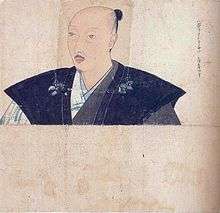Ashikaga Yoshiharu

Ashikaga Yoshiharu (足利 義晴, April 2, 1511 – May 20, 1550) was the twelfth shōgun of the Ashikaga shogunate who held the reins of supreme power from 1521 through 1546 during the late Muromachi period of Japan.[1] He was the son of the eleventh shōgun Ashikaga Yoshizumi.[2]His childhood name was Kameomaru (亀王丸).
- May 1, 1521 (Daiei 1, 25th day of the 3rd month): After the tenth shogun Ashikaga Yoshitane and Hosokawa Takakuni struggled for power over the shogunate and Yoshitane withdrew to Awaji Island, the way was clear for Minamoto-no Yoshiharu to be installed as shogun.[3]
- 1521 (Daiei 1, 6th month): Yoshiharu enters Kyoto.[1]
- 1526 (Daiei 6, 12th month): Shōgun Yoshiharu invited archers from neighboring provinces to come to the capital for an archery contest.[4]
Not having any political power and repeatedly being forced out of the capital of Kyoto, Yoshiharu retired in 1546 over a political struggle between Miyoshi Nagayoshi and Hosokawa Harumoto making his son Ashikaga Yoshiteru the thirteenth shogun.
- 1568 (Eiroku 11): Supported by Oda Nobunaga, his son Ashikaga Yoshiaki became the fifteenth shogun.[1]
From a western perspective, Yoshiharu is significant, as he was shogun in 1542, when the first contact of Japan with the European West took place. A Portuguese ship, blown off its course to China, landed in Japan.
Family
- Father: Ashikaga Yoshizumi
- Mother: Hino Akiko
- Wife: Keijuin (1514–1565),
- Concubines:
- Oodate Tsuneoki's daughter
- Children:
- Ashikaga Yoshiaki by Keijuin
- Ashikaga Yoshiteru by Keijuin
- Ashikaga Shuko (d. 1565)
- Shiratori Yoshihisa (d. 1547)
- daughter married Takeda Yoshimune
- daughter married Miyoshi Yoshitsugu
- daughter married Karasume Kosen
- Nun in Hyokoji temple
Events of Yoshiharu's bakufu
Significant events shape the period during which Yoshiharu was shōgun:[6]
- 1521 – Hosokawa Takakuni has Yoshiharu appointed shōgun.[1]
- 1526 – Kasai rebels, Miyoshi rebels: Go-Nara succeeds.[1]
- 1528 – Yoshiharu driven out by Miyoshi Nagamoto.[1]
- 1533 – Ikkō rebellion.[1]
- 1536 – Go-Nara enthroned.[1]
- 1538 – Dissension in Koga Kubō's family.[1]
- 1546 – Yoshiharu flees to Ōmi; his son, Yoshiteru, appointed shōgun in exile.[1]
Eras of Yoshiharu's bakufu
The years in which Yoshiharu was shōgun are more specifically identified by more than one era name or nengō.[7]
Notes
- 1 2 3 4 5 6 7 8 9 10 Ackroyd, Joyce. (1982). Lessons from History: The Tokushi Yoron, p. 332.
- ↑ Titsingh, Isaac. (1834). Annales des empereurs du japon, p. 370., p. 370, at Google Books
- ↑ Titsingh, p. 371., p. 371, at Google Books
- ↑ Titsingh, p. 373., p. 373, at Google Books
- ↑ Titsingh, p. 379., p. 379, at Google Books
- ↑ Ackroyd, p. 331.
- ↑ Titsingh, pp. 370–378., p. 370, at Google Books
References
- Ackroyd, Joyce. (1982) Lessons from History: The Tokushi Yoron. Brisbane: University of Queensland Press. ISBN 9780702214851; OCLC 7574544
- Titsingh, Isaac. (1834). Nihon Ōdai Ichiran; ou, Annales des empereurs du Japon. Paris: Royal Asiatic Society, Oriental Translation Fund of Great Britain and Ireland. OCLC 585069
| Preceded by Ashikaga Yoshitane |
Shōgun: Ashikaga Yoshiharu 1521–1546 |
Succeeded by Ashikaga Yoshiteru |
